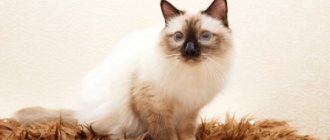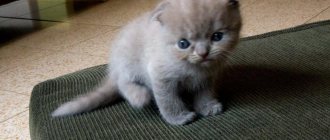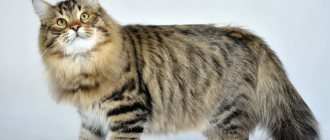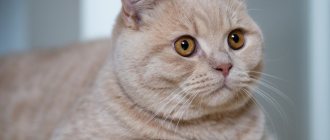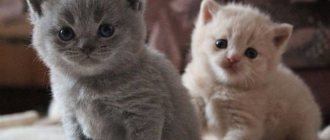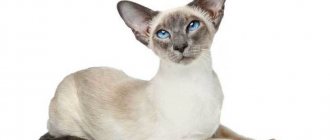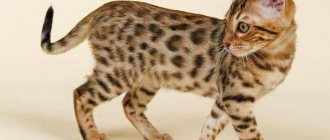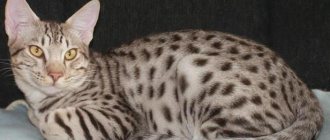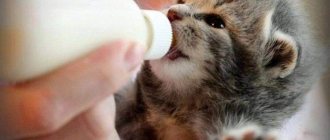Among pet lovers there are quite a lot of fans of Scottish Straight cats. The nature of the pets allows them to be kept in families with small children. However, the breed requires care and knowledge of the animal’s character. In order for your pet to feel good, you should take proper care of it. Scottish cats are a breed that appeared relatively recently, but in a short time the animals were able to win the hearts of both ordinary breeders and charm people specializing in breeding. At first glance, the appearance of the pets is ordinary, but there are quite unusual and exceptional features that attract many. Representatives of the Scots sometimes look formidable, sometimes strict, but at the same time they are always so sweet.
Some confusion
The Scottish Straight cat, the photo of which is presented in this article, is a close relative of the Scottish Straight. However, the characters of the animals are radically different. Often the habits of the latter cause bewilderment among breeders; they cannot be kept in a family with children due to excessive aggressiveness and intolerance even with small pranks.
The characteristics of Scottish straight-eared cats are radically different. They are completely different from their relatives. However, before purchasing them, it is necessary to find out the characteristics of the animal’s character and its standard habits, so that if difficulties arise in upbringing, you will be able to cope with them.
History of the origin of the Scottish Straight cat
global $ads_google;
//data-ad-slot=”2475549904″ $ads_google = empty($ads_google) ? false : true; ?> if ($ads_google == false) {?> $ads_google = true; ?> } ?> Today, Scottish Folds are considered more elite and valuable. Although without straights, folds would simply disappear. On the other hand, Scottish Straights are the same cats with drooping ears, whose hearing organs have retained an upright position by the age of one month. In general, the two types of these Scottish cats could not exist without each other. Therefore, the “chronicle” of the existence of the breed begins with the birth of the first fold-eared kitten named Susie.
In the early 60s of the last century, British felinologist William Ross discovered an amazing cat cub with forward-curved ears in one of the cities of Scotland. The breeder and his wife were fascinated by the white fluffy cat. A couple of British cat lovers immediately realized what potential was hidden in the unusual offspring born from a completely ordinary cat.
A few years later, Susie brought kittens to her owners, one of which inherited her mother’s exterior features. The young snow-white female was given the name Snook. Having resorted to the help of a geneticist, Ross began breeding Scottish Folds. During selection, it turned out that an autosomal dominant gene is responsible for the special structure of the hearing organs in cats. That is, this is a “sick” trait that is inherited, and this “detail” of appearance is more likely a flaw than a source of pride.
Despite this, William Ross continued the experiment. To breed Scottish pets, he mated them with British shorthair cats and ordinary domestic cats. The first year of work has already been very fruitful. A British felinologist managed to breed about 40 Scottish Folds and 30 Scottish Straights .
The ears of the fruits of genetic experiments were similar to those of rabbits, so at first the representatives of the breed were simply called lop-eared. Later, by 1966, they became known as folds. At the same time, wonderful cats were officially registered for the first time. However, soon experts began to worry that floppy ears could cause frequent infections and even deafness. The more pressing problem was the animal's unstable gene pool. For this reason, British organizations stopped the registration of the Scots, after which the cats went to conquer America.
In the states, scientists began to rehabilitate the breed and improve the set of genes. By 1973, the fluffy Scottish Sheep were approved by the CFA and ACA, and five years later they received championship status.
Description of the Scottish Straight cat
Scottish cats differ in a number of characteristic features that are unique to this breed. Sometimes animals are often confused with the British species, but during the comparison process the following differences can be identified:
- more rounded head;
- the body has an oblong and elongated shape, which gives the animal elegance;
- body proportions are slightly reduced;
- the average weight of a cat is 3 - 5 kg, boys weigh slightly more than females;
- pets are very flexible and remain hardy and playful at any age.
Prohibitions
There are foods that are strictly not allowed for feeding cats:
- potatoes and any dishes made from them;
- greens and grass grown on the windowsill or purchased in special stores;
- pasta and food with spices and herbs;
- fatty meats such as pork;
- dairy products with a high percentage of fat content.
Taking into account the structural features of bone and cartilage tissue, it is necessary to regulate your pet’s nutrition in such a way that it receives all the necessary nutrients, especially in the period up to 1 year, so the nutrition of a straight-eared British kitten is of great importance in the process of care, and its regulation ensures the health and longevity of your cat.
© shutterstock
Straight-eared Scottish cat: character and habits
Inexperienced breeders often wonder how to determine in advance the future character of a kitten. It is well known that Scottish Straight babies show a special disposition already in the first months of life. As soon as the babies' eyes appear and they begin to crawl around the apartment, it becomes clear whether the cat will be balanced and obedient. Perhaps he will become a tireless and energetic researcher. Or perhaps the kitten will become a phlegmatic, calm cat.
Kittens of this breed, even born from the same mother cat, may be completely different in habits and character from each other. Sometimes it seems that it is impossible to determine which of the mischievous kids will be the optimal pet for a particular family.
color-point groups
The activity of the point color gene is activated when it is present in two sires. Scientific research has revealed that individuals of this color are partly albinos. At birth they have a snow-white coat color, which later turns into color point. In the first month of life, the ears darken, a month later - the nose, and then the entire muzzle. Dark spots should be intense, contrasting relative to the body.
Color changes when exposed to heat or cold. To maintain purity and uniformity of color, such animals require warm conditions.
Scottish Straight SFS 71 b 33
British longhair ny 21 33 03
Solid colors
Solid color point varieties are widespread among furry representatives of the British breed. Owners of the classic color point have a very light body framed by areas of the main color.
The fur is short, with a dense structure. The correct color is contrasting, the hairs in dark areas are evenly colored. The color of the point marks is clear, intense, no blurring, no dyed white hairs. The point markings, nose, and pads on the limbs are characterized by a single color.
British shorthair red point BRI d 33
Blue-eyed Lilac-point cat BRI c 33
Offspring with a solid color point in British and Scottish cats can only be obtained from sires with this coat color or from carriers of the corresponding gene. It is also important for older ancestors to be solid color point or have a gene for this color in their genotype and the ancestors of both parents should have it. As mentioned earlier, newborn kittens do not have point markings. Darkening appears on the limbs, tail, ears, and muzzle later. It is interesting that the intensity of the shade of point marks in British cats depends on their age; in more mature individuals, the color is more saturated in tone.
Scottish straight blue point cat SFS 71 a 33
Scottish fold cat with blue eyes SFS c 33
The varieties are shown in the table.
| A variety of solid point | BRI code | Body tone | Point marks | Eyes | Tone of paw pads, nose mirrors |
| Black | seal point | Seal-point | n 33 | Warm white, light beige, beige, cream | Dark brown | Light blue, blue | Dark brown |
| Blue | blue point | Blue-point | a 33 | From cool white to bluish gray | Blue | Light blue, blue | Gray-blue |
| Cream | Cream-point | e 33 | White with a slight milky tint | Cream | Light blue, blue | Beige coral |
| Lilac | lilac point | Lilac-point | c 33 | Almost white, sometimes with a purple tint | Gray pink | Light blue, blue | Gray pink |
| Red | red point | Red-point | d 33 | White with pink or apricot tint | Orange or red | Light blue, blue | From red to coral |
| Chocolate | chokelit point | Chocolate-point | b 33 | Ivory | Chestnut brown | Light blue, blue | Chestnut brown |
| Faun | Fawn-point | p 33 | Light sand | Warm brown with beige tint | Light blue, blue | Pink sand |
| Cinnamon | Cinnamon-point | o 33 | Ivory | Bright brown with a red tint | Light blue, blue | Pink brown |
Scottish cat SFS 71 b 33
Scottish Fold Shorthair SFS n 33
The main thing for a black point is a clear contrast between the shade of the body and the point markings. The points will be almost black if the body is dark and light if the body is white.
Cream Points have very little contrast between the cream-colored point markings and the lightened, milky body. In such a situation, it is important to observe the color of the eyes, which, according to the rules, should look bright and intense. In addition, the British Cream Point coat has a residual pattern, which is a genetic feature of this color. The formation of color is completed by one to one and a half years.
Red color-points among British cats have the same characteristics. They are distinguished by the presence of a residual pattern on the coat; the final shade will be formed by one to one and a half years.
The body color and point markings of the British lilac-point do not contrast strongly with each other, but there is a pronounced, clear transition.
Tabby point | BRI x 21 33
This color is notable for the presence of a tabby pattern on the points. Its color refers to the main or one of the tones of the mosaic. Markings cover the frontal part of the head (the letter “M”), the area around the antennae, and the eyes.
On the very light body the pattern is absent, but appears on the forelimbs as torn rings and stripes on the thighs. The ear is marked on the outside with a light spot.
BRI from 21 33 lilac-tubby-point
The paw pads and nose are colored the same color as the markings. Tabby points correspond to codes 22, 23 and 24 (marble, tiger and spot, respectively).
Links | lynx are designated with a single code 21, regardless of the tabby variety.
Therefore, to indicate a specific color, it is customary to add the number 21 to the code. For example, seal tabby point will be designated as BRI n 21 33, seal tortie tabby point – BRI f 21 33...
Color point with white
This is a complex color. Its representatives must meet the standards of two colors: color point and bicolor. The tail, ears and paws (as a rule, only the hind legs) are characterized by darkening, but the cheeks in the area of the mustache and nose are often spotted, with white spots. The front legs are almost always white. Half to a third of the cat’s body is also covered with the same color.
The British with this color have eyes of a standard shade - sky blue or blue. The shade of the nose and paw pads is according to the standard.
Kitten blue golden tabby point with white BRI ay 21 33 03
Long-haired kitten chocolate golden tabby point harlequin BLH by 21 33 02
To breed color-point bicolor offspring, you need a pair of cats of the same color or carriers of the gene. The parents' pedigree must contain pointing, white-haired Britons. Colorpoint British kittens are born without point markings. Dark areas appear as babies grow.
BLH cy 11 33 03
There are the following combinations of shades among the British:
| BRI code | X ‒ point bicolor | X - point with white |
| n 03 33 | seal | black |
| a 03 33 | blue | blue |
| b 03 33 | chocolate | chocolate |
| from 03 33 | lilac | lilac |
| d 03 33 | red | red |
| e 03 33 | cream | cream | cream |
| p03 33 | fawn | faun |
| o 03 33 | cinnamon | cinnamon |
BLH ny 21 33 03
Highland fold SFL n 21 33 03
BSH bs 21 33 03
lilac gold shaded point with white cy 11 33 03
Smoky color point | BRI xs 21 33
British, Scots with this mixed shade must comply with the standards of smoky color, color point. These cats have a white undercoat under light hairs, a darkened tail, paws, muzzle, and ears, and the ears seem to be sprinkled with silver. The presence of a tabby pattern on the coat is rejected. British shorthair and longhair cats of similar color have blue eyes, and the pads on their paws, nose and point markings are the same color.
BRI as 21 33
BSH cs 21 33
Darkened areas of the body in British people with smoky color point:
| BRI code | X smoky color point |
| ns 21 33 | black |
| as 21 33 | blue |
| bs 21 33 | chocolate |
| cs 21 33 | lilac |
| ds 21 33 | red |
| es 21 33 | cream | cream |
| PS 21 33 | faun |
| os 21 33 | cinnamon |
as 21 33
BRI as 2133
Torty Point | tortie point | tortoiseshell point
Another variety of mixed colorpoints among the British is the tortoiseshell. The body of the animal is tinted in a light color, while the points are painted in the basic color with a tortoiseshell mosaic. The presence of large and distinct black and red spots is a defect.
It is rare to see a tortie point. It is possible to breed this shade of fur from the offspring when one of the parents is tortoiseshell and the other is a color point.
BRI f 33 03 black tortoiseshell point bicolor
British longhaired chocolate tortoiseshell point bicolor BLH h 33 03
Possible color combinations for the British tortie point:
| BRI code | X tortoise point |
| r 33 | fawn-cream |
| j 33 | lilac-cream |
| g 33 | blue-cream |
| q 33 | cinnamon-red |
| h 33 | chocolate red |
| f 33 | black-red |
Shaded Point | shaded color point
The base shade of the British coat can be golden or silver. At the same time, the third part of the hairs in the tipping on the back is made in the main color. From color point, representatives of this color have a darkened tail, ears and muzzle. The rim around the nose is painted in the main color, as is the outline around the sky blue eyes. The eyes are surrounded around the perimeter by white fur. The color of the pads on the limbs corresponds to the color. The presence of tabby marks is a defect.
BLH by 11 33
BLH ny 11 (25) 33
Color combinations of shaded color point:
| BRI code | X shaded point | Description |
| as 1133 | blue silver | Silver base with blue tipping and markings. The nose is pink, the rims of the eyes and nose, and the eyes themselves are blue. |
| ay 1133 | blue gold | The base is gold, blue shading and blue point color. The nose is pink, the eyes are blue, and there is a dark blue rim around them. |
| ns 1133 | black silver | This Briton has a main shade of silver with black points. Pinkish nose and blue eyes with black edging. The color of the pads on the paws is black. |
| NY 1133 | black gold | This color combines golden shading with black pointing. There is a black rim around the blue eyes. The nose is pink with a black border around it. |
BLH n 11 33
Chinchilla Point | veiled color point
The main tone of veiled British cats can be either gold or silver. Tipping fur is ⅛ of the main color, usually black. There is darkening of the tail, ears, and muzzle. The outline of the nasal mirror and the eyes are colored in the main tone. The eyes are blue with snow-white fur around the perimeter. The color scheme of the paw pads corresponds to color point standards. The tabby pattern is considered a breed culling.
Colors of veiled color point:
| BRI code | X veiled point |
| PS 1233 | faun silver |
| OS 1233 | silver cinnamon |
| bs 1233 | chocolate silver |
| cs 1233 | lilac silver |
| ay 1233 | blue golden |
| as 1233 | blue silver |
| NY 1233 | black golden |
| ns 1233 | black silver |
BRI ny 12 33
In order for British kittens to inherit the color point color, you need to breed two cats of the same color, or a pair of carriers of the corresponding gene. At birth, the offspring do not have point marks; as the animal grows, the paws, ears, muzzle and tail darken.
Naughty family friend
Young Scots with a strong temperament are constantly trying to run away somewhere, hardly sit still and are actively exploring the world around them.
Inquisitive furry creatures sniff very carefully at unfamiliar smells, listen to any rustles, frolic with their brothers and sisters for a long time and always try to stir them up.
Playful animals show their hunting instincts at any convenient moment. Such kittens are either trying to catch their tail or hunting for shadows. But in any case, they are the only ones who initiate playful pursuits.
Balanced and calm family member
If you need to get a non-capricious and balanced kitten who will not constantly jump and regularly demand attention, you need to take a closer look at the babies who sit apart in the basket. Usually such kids do not participate in the fun of others, and if they are drawn into the game, then the kittens join in without much enthusiasm.
Balanced kids love to sleep and spend a lot of time alone. If they begin to explore the surrounding space, they do it alone.
There is even a pattern by which you can identify a calm, straight-eared Scottish cat. The character and habits of such a baby will be distinguished by calmness and balance in its external and internal manifestations. The kitten carefully touches various objects with its paw, does not strive to constantly be the center of attention and does not involve other pets in its explorations.
Such an animal gets very used to its owners and becomes a family favorite. Usually these cats are immersed in themselves and try to somewhat isolate themselves from others.
Factors influencing the habits of the Scots
Scottish straight-eared cats are gaining popularity among ordinary people and professional breeders due to their character and unusual appearance. Animals can react quite adequately to children's pranks, so their nature allows them to be kept in families with children.
The character, habits and habits of the breed can be influenced by various factors and life circumstances. Therefore, the characteristics of Scottish straight-eared cats can be directly related to the very upbringing of the kitten and the conditions of its keeping. The breeder needs to pay attention to:
- pet's habitat;
- his surroundings.
Habits can change greatly due to the presence of other animals in the house, as well as due to various medical procedures required for Scottish Straight cats. The character of a sterilized or neutered animal differs from that of the one that bears offspring. Let's consider the factors that most influence the breed's leashes next.
Standard color point color
With the correct color point color, the color of British cats should be high-contrast and bright. There is a clear boundary between the light-colored body, darkened paws, muzzle, and ears. Residual patterns and spots on the body are considered defective.
The British colorpoint are the owners of very beautiful eyes - blue or blue, and the saturation of the shade is most valued. A genetic feature of color points is the low production of melanin, which determines the only eye color. This is the uniqueness of this color relative to others.
Color Point Britons have another alternative name - Siamese Britons. They have dense hair and a white undercoat.
Surrounding area
Reviews about the habits of the Scottish straight-eared cat and the nature of his behavior confirm the fact that these are quite calm and balanced animals. Professional breeders say that pets can change significantly due to the human factor. For example, the presence of mischievous children in the house can have both a negative and a completely positive effect on a kitten.
If adults allow children to treat kittens roughly and cruelly, not realizing that pets are vulnerable and weak, then as they grow up, the animals may become withdrawn, angry and suspicious. Cases have been recorded when pets began to take revenge on their owners. If children and adults approach the cat with affection and are kind to it, then the animal grows up calm and, depending on its disposition, mischievous or peaceful.
Location
Place of residence and living conditions have a great influence on the formation of the character of the Scottish Straight cat. The character of the animal greatly depends on these circumstances. It is known that without proper care, animals have difficulty adapting to their environment and become angry, aggressive and withdrawn. However, the breed is very self-sufficient. A cat needs its own private corner where it can feel comfortable and relax.
Scots are very attached to home and family members. Relocation has a serious impact on them. Such changes in life can turn a self-confident animal, affectionate and playful, into a cowardly and embittered one.
Reviews about the character of the Scottish Straight cat indicate that he can live quite comfortably in the courtyard of a private house. Animals are excellent catchers and getters. They often defend their possessions from rodents, birds and other creatures and also obtain their own food.
If a Scotsman lives in an apartment, then the kitten grows up less active and independent. However, reviews indicate that in this case the animal is more attached to the person and shows its affection more actively.
Such pets love to sleep on the laps of household members and play gambling with children, if they are not cruel. Also, the Scots are quite peaceful with other pets. But, according to reviews from most breeders, Scottish Straight cats are very picky when it comes to nutrition.
Presence of other animals in the family
Scottish Straights often look down on other pets. However, if they were brought up with such people from childhood, then such an attitude does not arise. When a kitten ends up in a home inhabited by other animals, the owners can rest assured of a positive outcome. The baby will definitely get along not only with his relatives, but also with birds, tame rodents and even dogs.
The character of the Scottish straight-eared cat, who grew up in the same house with dogs, is distinguished by mischief and cheerfulness. These animals are cheerful, agile and very attached to their owner.
But living in the same house with felines, the Scots can become overly jealous. In this case, they become attached to cats more than to members of the household and the owner.
Kitten selection criteria
You should choose a kitten taking into account the breed standards. All small kittens of the Scottish breed have straight ears, and what they will be like will become clear in a few months. You shouldn’t take a kitten to a new home too early: with mother’s milk, kittens receive the necessary nutrients that strengthen their immune system.
In order for the offspring to be healthy, breeding rules must be followed. And if you were told that the kitten’s father is a “purebred British” and his mother is a “Scottish” fold, the kitten is unlikely to grow up healthy. Mating a Scottish cat is only possible with a representative of the same breed - a “Scottish cat”. Alas, there are often unfortunate breeders who think only about profit and not about the health of the animals.
Leisure influencing character
The character of Scottish straight-eared male cats is somewhat different from girls. Males more often show their hunting skills, strive to get their own food and show strength in the process of protecting themselves. Females are more affectionate and playful, but if they have offspring, they can show aggression.
In order for a kitten to develop harmoniously, it needs a variety of toys. If there are a lot of them, then the pet is unlikely to turn into a glutton, a calm phlegmatic person or a lump. Such a Scot will be characterized by agility, energy and a desire to hunt.
The Scot as a true friend
Many people want to get a representative of this breed because the animals are obedient. For your pet to understand that they are angry with him, it is enough to change his intonation. Reviews from breeders show that it is quite easy to train small kittens to use a tray. If necessary, they can relieve their needs in the courtyard of a private house. Scottish Straight cats quickly learn what is permissible to do in the house and what will be punished. Many Scottish owners say that it is not scary to leave such a pet at home alone, because it does not harm property. Often breeders find an animal in the same place where it lay before they left.
However, this does not mean that the animal is inactive. Scottish Straight cats are very inquisitive and playful. Animals often do not know how to stop when participating in games, so it is worth limiting pets in their natural instincts and not allowing them to scratch themselves or household things.
Catering
The issue of feeding should be approached with all seriousness: you cannot feed a living creature with just anything.
Food that is fatty, over-salted, with artificial preservatives and dyes in its composition will not bring any benefit to your pet, but it can “add” the stomach, liver, and other organs literally once or twice. And not all food from your table is suitable for an animal, even if it is good for you.
Natural products
Digestion is significantly different between humans and cats. The first thing a cat needs is calcium, phosphorus and taurine.
- And these substances can only be obtained from raw meat, lean and fresh: beef, chicken, rabbit, turkey, veal, lamb. During heat treatment, calcium transforms into a form that is practically not absorbed by the body, and taurine completely disintegrates. Meat components (muscle meat, offal, meat bones) should make up 90% of the daily diet.
- 5-10% are vegetables. Pumpkin, carrots, asparagus, zucchini, green beans, cauliflower, broccoli, greens (parsley, dill): vegetables are boiled or stewed and mixed with cereals. Cats rarely eat raw food.
- Rice, millet, oatmeal, buckwheat, semolina and pearl barley porridge are allowed. You can feed your cat with them every other day. Porridge is cooked in plain water without adding sugar, salt or seasonings.
- Chicken and quail eggs can be given no more than 2 times a week. Quails are boiled and fed whole; chicken ones are given only the yolk.
- Fish - flounder, hake, trout, salmon, tuna, navaga, saury, mackerel, ivashi, burbot, tench, chum salmon, carp - contains easily digestible protein, omega-3 and omega-6, and vitamins. But there is practically no calcium there, which causes problems with the musculoskeletal system in Scottish Straight cats. Therefore, fish can be given in small pieces along with meat and no more than once a week. Lack of fish will not negatively affect your cat's health if you add fish oil to the food.
- Low-fat fermented milk products - sour cream, yogurt, fermented baked milk, cream, cottage cheese, unsalted hard cheese - can be given every day, preferably in the afternoon.
- Vitamin-mineral complex, dry yeast in tablets, spirulina, kelp, sprouted alfalfa are very useful and should also be included in the diet.
Potatoes, legumes, cocoa-containing products, juices, alcohol, citrus fruits, bones, flour products and baked goods are prohibited!
Clean water at a comfortable temperature should always be available! You cannot give your animal water directly from the tap: tap water contains bleach and other components hazardous to the cat’s health.
Recommended food
From industrial feeds, choose only super-premium and holistic feeds. Go Natural, Savarra, Wellness CORE - these foods are recommended by both breeders and veterinarians.
Below are recommended super-premium foods. Links with the names of the food are clickable, on them you can, within our website, get acquainted with the descriptions of the food and read reviews from owners of cats of the Scottish Straight breed.
| Holistic | Super premium | Super premium |
| Wildcat | Golosi | Karmy |
